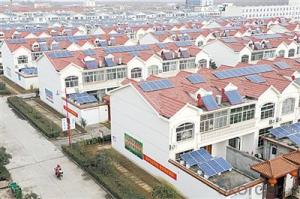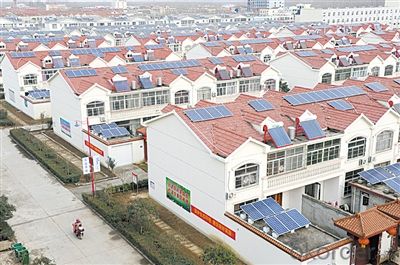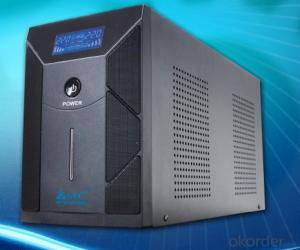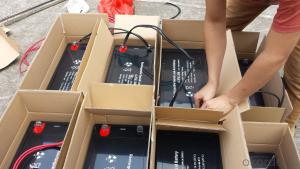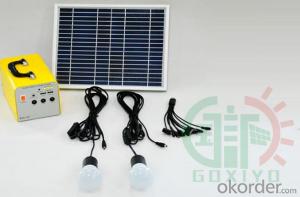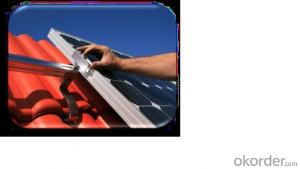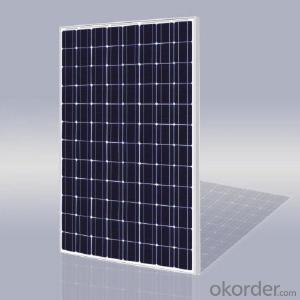Sharpe Solar Energy Systems - Roof Solar Power System Hot Sale Good Design
- Loading Port:
- Shanghai
- Payment Terms:
- TT or LC
- Min Order Qty:
- 500 watt
- Supply Capability:
- 2000000 watt/month
OKorder Service Pledge
OKorder Financial Service
You Might Also Like
| Quick Details | |||||
| Specification: | Normal | Application: | Home | Output Voltage (V): | AC110V/220V |
| Load Power (W): | 3KW | Solar Power (W): | 3KW | Work Time (h): | 48 |
| Cables: | 50m | Solar Panel Rack: | Optional | Battery Capacity: | 12V/200AH*8pcs |
| Controller Voltage: | 48V | Inverter Output Voltage: | AC220V/110V | Efficiency: | 90% |
| Inverter: | DC48V | Rated Output Capacity: | 3000W | Solar Panel Power: | 250w*12pcs |
| Solar Panel Type: | Crystalline Silicon PV Module | ||||
| Packaging & Delivery | |||||
| Packaging Detail: | using carton or wooden box as per customer's requirement. | ||||
| Delivery Detail: | within 10~30 days for shipment depending on order quantity | ||||
Excellent battery backup 300W to 10KW off grid solar system with grid power switch
Anern Advantage:
1) Over 10 year experience in clean energy line, business covering solar street light, solar garden light, off grid
solar system and on grid solar power system, etc;
2) Exporting for worldwide, with satisfied clients more than 50 countries;
3) Competitive price, excellent service, integrated certificate system;
We supply CE, RoHS certificates if you need
Welcome to visit our factory at any time.
Solar system advantages:
1. CE, ROHS approved.
2. High conversion efficiency, high-transmission rate.
3. Energy saving, environmental-friendly.
4. Advanced technology, strict quality control system.
5. Easy installation, safe operation, free maintenance.
6. Low MOQ, fast delivery time, long service life
Specifications:
| Ref No. | OFF-SGHP-3KW | |
| System Basic Information | Solar Panel Rated Output Power | 3KW |
| Suitable for Max Daily Power Consumption | 10KWH | |
| Rated Output AC Capacity | 3KW | |
| Solar panel | ||
| Type | Crystalline Silicon PV Module, A-class | 12pcs |
| Max Power | 250W | |
| Vmp | 30.5V | |
| Size | 1655*992*45mm | |
| Weight | 22.5kg/pc | |
| 25 years power output guarantee (Note: 2pcs panels connect in series) | ||
| Controller | ||
| Voltage | 48V | 1pc |
| Current | 60A | |
| Warranty | 1 year | |
| PWM high-efficiency charging controller, LED display, intelligent control; Temperature compensation, various protections. | ||
| Circuit Breaker | Used for protection of controller, installed between PV array combiner and controller | 1pc |
| Inverter | ||
| Input Voltage | DC48V | 1set |
| Output Voltage | AC220V/110V 1-phase | |
| Frequency | 50/60Hz | |
| Efficiency | 90% | |
| Note: This inverter provides grid power switch and battery charging functions. | ||
| Battery | ||
| Capacities | 12V/200AH per piece | 8pcs |
| Service life | 5 to 6 years | |
| Warranty | 3 years | |
| Solar panel rack | Flat-roof type mounting rack, steel material, anti-rust treatment | 1 set |
| (Other types of racks can be customized as per client's requirement) | ||
| Cable | 50m | |
| Connectors | 3-terminal connectors, used for panels connection in parallel | 6 set |
Product features:
1. Off grid solar power system is mainly used for application with relatively-small power consumption, and the areas have no grid network coverage, or grid power is unstable or outage condition.
2. It’s composed of solar panels, hybrid solar inverter, battery bank, solar panel mounting racks, and other accessories required fora complete home solar power system.
3. The battery bank gives a stable power output to the solar inverter which converts DC to AC to power loads, and provides power backup in rainy or cloudy days.
4. The solar panels generate electricity at daytime and charge the battery bank .
5. The off grid home solar power system provides grid power bypass in case of battery power shortage when sunshine is not enough.
6. All the off grid home solar power system configurations are worked out by scientific calculation and design.
Features:
1.Environmental protection
2.Energy-saving products
3.Portable
4.easily use
Advantages:
1.Safety and easy installation,Plug and play systems;
2.Good quality panel to ensure the high efficiency and long life needs;
3.Solar Automatic lighting controller :with adjustable run times, over-current protection;
4.Solar Batteries: Maintenance free, long life batteries
5.Lighting Source: LED lamp /Lantern (Fixed/Movable)
7.Flexible designs per client requests;
Using of scope:
It is very good for indoor use where there is shortage of electricity and for outdoor activities such as picnicking, fishing and camping. It is an ideal tool for Motor Mechanics, Farm House and small shop owners such as Hairdressers, Barbers, Cobblers, Tailors and Kiosk keepers.
- Q: What is the role of power optimizers in a solar energy system?
- The role of power optimizers in a solar energy system is to maximize the energy output of each individual solar panel. They work by individually tracking and optimizing the power output of each panel, which allows for better performance in shaded or unevenly performing panels. Power optimizers also improve system safety by reducing the voltage of the DC power generated by the panels, making the system more efficient and safer to install and operate.
- Q: Do solar energy systems require planning permission?
- Yes, solar energy systems typically require planning permission in most regions. The exact regulations and requirements may vary depending on the location and the specific characteristics of the system. It is advisable to consult with local authorities or a professional installer to ensure compliance with the relevant planning regulations and obtain proper permission before installing a solar energy system.
- Q: Can solar energy systems be used for powering irrigation systems?
- Yes, solar energy systems can be used to power irrigation systems. Solar panels can generate electricity that can be used to operate pumps and other equipment necessary for irrigation. This can provide a sustainable and cost-effective solution for powering irrigation systems, especially in remote areas where access to electricity is limited. Additionally, solar energy is renewable and does not produce greenhouse gas emissions, making it an environmentally friendly choice for powering irrigation systems.
- Q: How do solar energy systems impact energy resilience during natural disasters?
- Solar energy systems can significantly enhance energy resilience during natural disasters. These systems provide a reliable and independent source of electricity, enabling critical infrastructure and essential services to continue functioning even when the main power grid is disrupted. Solar panels can continue generating electricity as long as there is sunlight available, reducing the reliance on fuel-dependent generators and minimizing the risk of fuel shortages during emergencies. Additionally, solar energy systems can be paired with battery storage, allowing excess energy to be stored and used during nighttime or cloudy periods. This combination ensures a continuous power supply, enabling emergency response efforts, communication networks, and healthcare facilities to operate, thereby enhancing overall energy resilience during natural disasters.
- Q: Can solar energy systems be used for powering shopping malls?
- Certainly, shopping malls can indeed utilize solar energy systems to power their operations. The sun's energy can be captured by installing solar panels on the rooftops or parking lots of shopping malls. This captured energy can then be converted into electricity, which can be used to power various functions within the mall, such as lighting, heating and cooling systems, escalators, elevators, and other electrical appliances. By embracing solar energy, shopping malls can greatly reduce their reliance on conventional energy sources and decrease their carbon emissions. Moreover, solar energy systems can contribute to long-term electricity cost savings for malls, as they produce clean and renewable energy. All in all, solar energy systems offer a feasible and sustainable solution for meeting the power needs of shopping malls.
- Q: Can solar energy systems be used for powering outdoor recreational activities?
- Yes, solar energy systems can indeed be used to power outdoor recreational activities. They can provide a sustainable and renewable source of power for various activities such as camping, hiking, and boating. Solar panels can be used to charge portable batteries or directly power devices like lights, fans, radios, and even small appliances. This allows outdoor enthusiasts to enjoy their activities while minimizing their environmental impact and reducing reliance on traditional energy sources.
- Q: Can solar energy systems be used for powering off-grid recreational vehicles?
- Yes, solar energy systems can be used to power off-grid recreational vehicles. Solar panels can be installed on the roof of the RV to capture sunlight and convert it into electrical energy, which can then be used to power various appliances and systems within the vehicle. This not only provides a sustainable and environmentally-friendly power source but also allows RV owners to enjoy freedom and independence from traditional electrical hookups while on their travels.
- Q: Can solar energy systems be used in powering swimming pools or spas?
- Certainly, swimming pools or spas can be powered by solar energy systems. Solar pool heating systems harness the sun's energy to warm the water in the pool or spa, presenting a more sustainable and economical option compared to traditional heating methods. Typically, these systems comprise solar collectors, a pump, and a filter. The solar collectors, typically positioned on the roof or ground, absorb sunlight and transfer its warmth to the pool water. The pump circulates the water through the collectors and returns it to the pool, ensuring a continuous flow of heated water. By utilizing a renewable energy source, solar energy systems for swimming pools and spas not only lower energy expenses but also contribute positively to the environment.
- Q: Can solar energy systems be used in areas with limited access to training programs?
- Yes, solar energy systems can be used in areas with limited access to training programs. Solar energy systems are designed to be user-friendly and can often be installed and operated without extensive technical knowledge or training. Additionally, there are numerous online resources and tutorials available that provide step-by-step guidance on installation, maintenance, and troubleshooting of solar energy systems. This allows individuals in areas with limited access to training programs to still benefit from the use of solar energy.
- Q: Can solar energy systems be used in powering government buildings or offices?
- Yes, solar energy systems can be used to power government buildings or offices. In fact, many government buildings around the world have already adopted solar energy systems as a means of reducing their carbon footprint and dependence on traditional energy sources. Solar panels can be installed on rooftops or in open spaces adjacent to government buildings, harnessing sunlight to generate electricity that can be used to power various activities within the buildings. This sustainable approach not only helps in reducing greenhouse gas emissions but also saves money on energy bills in the long run.
Send your message to us
Sharpe Solar Energy Systems - Roof Solar Power System Hot Sale Good Design
- Loading Port:
- Shanghai
- Payment Terms:
- TT or LC
- Min Order Qty:
- 500 watt
- Supply Capability:
- 2000000 watt/month
OKorder Service Pledge
OKorder Financial Service
Similar products
Hot products
Hot Searches
Related keywords
